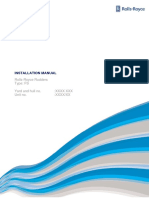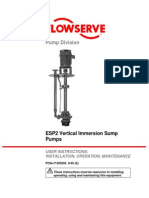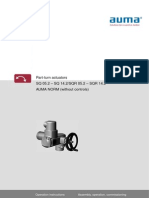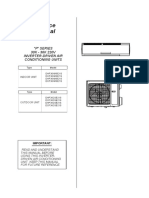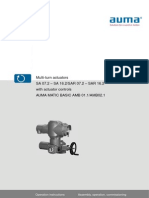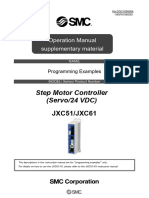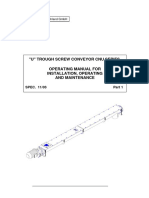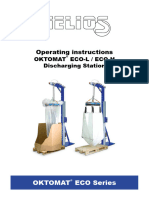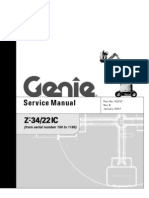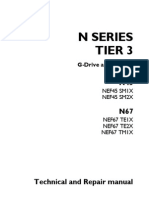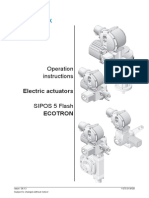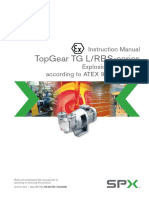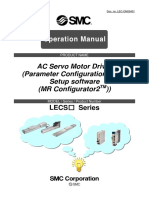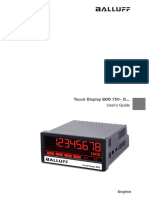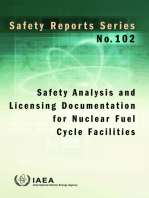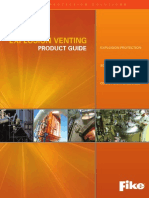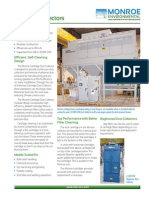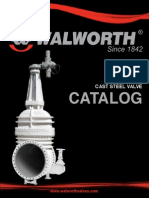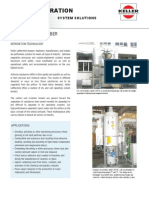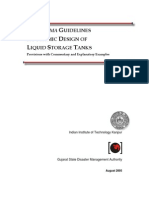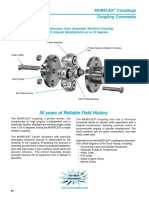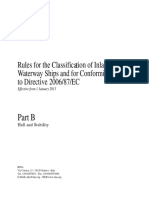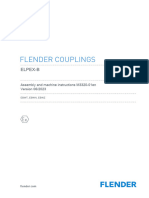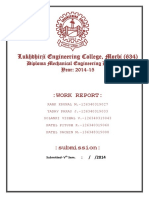Part-Turn Gearboxes GS 630.3: Assembly, Operation, Commissioning Operation Instructions
Part-Turn Gearboxes GS 630.3: Assembly, Operation, Commissioning Operation Instructions
Uploaded by
jpdavila205Copyright:
Available Formats
Part-Turn Gearboxes GS 630.3: Assembly, Operation, Commissioning Operation Instructions
Part-Turn Gearboxes GS 630.3: Assembly, Operation, Commissioning Operation Instructions
Uploaded by
jpdavila205Original Title
Copyright
Available Formats
Share this document
Did you find this document useful?
Is this content inappropriate?
Copyright:
Available Formats
Part-Turn Gearboxes GS 630.3: Assembly, Operation, Commissioning Operation Instructions
Part-Turn Gearboxes GS 630.3: Assembly, Operation, Commissioning Operation Instructions
Uploaded by
jpdavila205Copyright:
Available Formats
Part-turn gearboxes
GS 630.3
Assembly, operation, commissioning Operation instructions
Read operation instructions first.
Observe safety instructions.
These operation instructions are part of the product.
Preserve operation instructions during product life.
Pass on instructions to any subsequent user or owner of the product.
Purpose of the document:
This document contains information for installation, commissioning, operation and maintenance staff. It is intended
to support device installation and commissioning.
Table of contents Page
4 1. Safety instructions.................................................................................................................
4 1.1. Basic information on safety
4 1.2. Range of application
5 1.3. Warnings and notes
5 1.4. References and symbols
6 2. Identification...........................................................................................................................
6 2.1. Name plate
7 2.2. Short description
8 3. Transport, storage and packaging........................................................................................
8 3.1. Transport
9 3.2. Storage
9 3.3. Packaging
10 4. Assembly................................................................................................................................
10 4.1. Mounting position
10 4.2. Multi-turn actuators for motor operation
11 4.3. Mount gearbox to valve
14 5. Indications..............................................................................................................................
14 5.1. Mechanical position indicator/running indication
15 6. Commissioning......................................................................................................................
15 6.1. End stops in gearbox
15 6.1.1 End stop CLOSED: set
16 6.1.2 End stop OPEN: set
16 6.2. Seating in end positions via multi-turn actuator
17 6.2.1 Seating in the end position CLOSED: set
17 6.2.2 Seating in end position OPEN: set
17 6.3. Swing angle
18 6.3.1 Swing angle: modify
19 6.4. Mechanical position indicator: set
20 7. Servicing and maintenance...................................................................................................
20 7.1. Preventive measures for servicing and safe operation
20 7.2. Maintenance intervals
21 7.3. Disposal and recycling
22 8. Technical data.........................................................................................................................
22 8.1. Features and functions
23 8.2. Einsatzbereich
23 8.3. Further information
2
GS 630.3
Table of contents
24 9. Spare parts.............................................................................................................................
24 9.1. Part-turn gearboxes GS 630.3
26 9.2. Primary reduction gearing GZ 630.3 (4:1 and 8:1)
28 9.3. Primary reduction gearing GZ 630.3 (16:1 and 32:1)
30 9.4. Primary reduction gearing GZ 630.3 (64:1 and 133:1)
32 10. Certificates..............................................................................................................................
32 10.1. Declaration of Incorporation and EC Declaration of Conformity
33 11. Index........................................................................................................................................
34 Addresses...............................................................................................................................
3
GS 630.3
Table of contents
1. Safety instructions
1.1 Basic information on safety
Standards/directives Our products are designed and manufactured in compliance with recognised
standards and directives. This is certified in a Declaration of Incorporation and an
EC Declaration of Conformity.
The end user or the contractor must ensure that all legal requirements, directives,
guidelines, national regulations and recommendations with respect to assembly,
electrical connection, commissioning and operation are met at the place of installation.
Safety instructions/war-
nings
All personnel working with this device must be familiar with the safety and warning
instructions in this manual and observe the instructions given. Safety instructions
and warning signs on the device must be observed to avoid personal injury or property
damage.
Qualification of staff Assembly, electrical connection, commissioning, operation, and maintenance must
be carried out exclusively by suitably qualified personnel having been authorised by
the end user or contractor of the plant only.
Prior to working on this product, the staff must have thoroughly read and understood
these instructions and, furthermore, know and observe officially recognised rules
regarding occupational health and safety.
Work performed in potentially explosive atmospheres is subject to special regulations
which have to be observed. The end user or contractor of the plant are responsible
for respect and control of these regulations, standards, and laws.
Commissioning Prior to commissioning, it is important to check that all settings meet the requirements
of the application. Incorrect settings might present a danger to the application, e.g.
cause damage to the valve or the installation. The manufacturer will not be held
liable for any consequential damage. Such risk lies entirely with the user.
Operation Prerequisites for safe and smooth operation:
Correct transport, proper storage, mounting and installation, as well as careful
commissioning.
Only operate the device if it is in perfect condition while observing these instruc-
tions.
Immediately report any faults and damage and allow for corrective measures.
Observe recognised rules for occupational health and safety.
Observe the national regulations.
During operation, the device warms up and increased surface temperature may
occur. To prevent possible burns, we recommend checking the surface tempe-
rature using an appropriate thermometer and wearing protective gloves, if re-
quired, prior to working on the device.
Protective measures The end user or the contractor are responsible for implementing required protective
measures on site, such as enclosures, barriers, or personal protective equipment
for the staff.
Maintenance To ensure safe device operation, the maintenance instructions included in this manual
must be observed.
Any device modification requires prior consent of the manufacturer.
1.2 Range of application
AUMA part-turn gearboxes are designed for the operation of industrial valves, e.g.
butterfly valves and ball valves.
Other applications require explicit (written) confirmation by the manufacturer.
The following applications are not permitted, e.g.:
Industrial trucks according to EN ISO 3691
4
GS 630.3
Safety instructions
Lifting appliances according to EN 14502
Passenger lifts according to DIN 15306 and 15309
Service lifts according to EN 81-1/A1
Escalators
Continuous duty
Radiation exposed areas in nuclear power plants
No liability can be assumed for inappropriate or unintended use.
Observance of these operation instructions is considered as part of the device's
designated use.
1.3 Warnings and notes
The following warnings draw special attention to safety-relevant procedures in these
operation instructions, each marked by the appropriate signal word (DANGER,
WARNING, CAUTION, NOTICE).
Indicates an imminently hazardous situation with a high level of risk. Failure
to observe this warning could result in death or serious injury.
Indicates a potentially hazardous situation with a medium level of risk. Failure
to observe this warning could result in death or serious injury.
Indicates a potentially hazardous situation with a low level of risk. Failure to
observe this warning may result in minor or moderate injury. May also be used
with property damage.
Potentially hazardous situation. Failure to observe this warning may result in
property damage. Is not used for personal injury.
Arrangement and typographic structure of the warnings
Type of hazard and respective source!
Potential consequence(s) in case of non-observance (option)
Measures to avoid the danger
Further measure(s)
Safety alert symbol warns of a potential personal injury hazard.
The signal word (here: DANGER) indicates the level of hazard.
1.4 References and symbols
The following references and symbols are used in these instructions:
Information The term Information preceding the text indicates important notes and information.
Symbol for CLOSED (valve closed)
Symbol for OPEN (valve open)
Important information before the next step. This symbol indicates what is required
for the next step or what has to be prepared or observed.
< > Reference to other sections
Terms in brackets shown above refer to other sections of the document which provide
further information on this topic. These terms are either listed in the index, a heading
or in the table of contents and may quickly be found.
5
GS 630.3
Safety instructions
2. Identification
2.1 Name plate
Figure 1: Arrangement of name plates
[1] Gearbox name plate
[2] Additional plate, e.g. KKS plate (Power Plant Classification System)
Data for identification Figure 2: Gearbox name plate (example)
[1] Type and size - valve attachment (flange)
[2] Commission number
[3] Works number
[4] Reduction ratio [5] swing angle
[6] Factor [7] version
[8] Max. output torque (depending on flange size)
[9] Lubricant [10] enclosure protection
[11] Ambient temperature
[12] Explosion-proof version (option)
[13] Customer information (option)
Type and size These instructions apply to the following devices:
Part-turn gearboxes: GS 630.3
Primary reduction gearing: GZ 630.3
Commission number An order-specific commission number is assigned to each device. This commission
number can be used to directly download the inspection records and further
information regarding the device from the Internet: http://www.auma.com.
Reduction ratio The reduction ratio within the gearing and primary reduction gearing reduces the
required input torques and increases the operating time.
Factor Mechanical gearbox factor to determine the actuator size: Input torque = required
output torque/factor
6
GS 630.3
Identification
Version Figure 3: Version
For clockwise rotation of the input shaft (view on pointer cover/protection cover), the
first character of the version indicates the worm shaft position with reference to the
worm wheel, the second character indicates the valve shaft rotary direction.
Table 1: Version (with view on point cover)
Rotary direction of val-
ve shaft
Position of worm shaft Rotary direction at in-
put shaft
Version
clockwise right clockwise RR
counterclockwise left clockwise LL
counterclockwise right clockwise RL
clockwise left clockwise LR
2.2 Short description
AUMA worm gearboxes are part-turn gearboxes converting a rotary movement at
the input shaft into a part-turn movement at the output drive. They are driven either
via electric motor (by means of a multi-turn actuator) or manually (via a handwheel).
The required input torques are reduced due to high reduction ratios. In standard
version, internal end stops limit the swing angle to 100.
Worm gearboxes are available in different versions to implement various mounting
conditions and rotary directions.
7
GS 630.3
Identification
3. Transport, storage and packaging
3.1 Transport
For transport to place of installation, use sturdy packaging.
Transport gearbox and actuator separately.
Hovering load!
Risk of death or serious injury.
Do NOT stand below hovering load.
Attach ropes or hooks for the purpose of lifting by hoist only to housing and NOT
to handwheel.
Check available eyebolt for tight seat in housing (verify reach of the screw).
Fix ropes or hooks to gearbox using available eyebolts only.
Respect total weight of combination (gearbox, primary reduction gearing, actua-
tor).
Unpacking To lift the combination out of the transport box, follow illustrations [1] or [2]. Arrange
straps to ensure that the suspension point is perpendicular to the centre of gravity
of the combination.
Figure 4: Lift the gearbox using eyebolts (retention force max. 6.6 t for 2 eyebolts)
[1] Lifting with 4 eyebolts (out of the transport box)
[2] Lifting with 2 eyebolts and additional rope or sling
[3-6] Lifting with 2 eyebolts
8
GS 630.3
Transport, storage and packaging
For [3] and [6]: Danger of bending parts when lifting!
Pinching and damage at end stop or at actuator.
For illustration [3] and for illustration [6] with mounted actuator: Shim gearbox
with appropriate material and support to ensure that end stop or actuator is not
loaded with the total gearbox weight.
Table 2:Weights with coupling (with pilot bore) and grease filling in the gear housing
Weight [kg] Type
4,800 GS 630.3
5,300 GS 630.3 with primary reduction gearing GZ 630.3 (4:1/8:1)
5,500 GS 630.3 with primary reduction gearing GZ 630.3 (16:1/32:1)
5,600 GS 630.3 with primary reduction gearing GZ 630.3 (64:1/133:1)
3.2 Storage
Danger of corrosion due to inappropriate storage!
Store in a well-ventilated, dry room (maximum humidity 70 %).
Protect against floor dampness by storage on a shelf or on a wooden pallet.
Cover to protect against dust and dirt.
Apply suitable corrosion protection agent to uncoated surfaces.
Long-term storage If the device must be stored for a long period (more than 6 months) the following
points must be observed in addition:
1. Prior to storage:
Protect uncoated surfaces, in particular the output drive parts and mounting
surface, with long-term corrosion protection agent.
2. At an interval of approx. 6 months:
Check for corrosion. If first signs of corrosion show, apply new corrosion protec-
tion.
3.3 Packaging
Our products are protected by special packaging for transport when leaving the
factory. The packaging consists of environmentally friendly materials which can easily
be separated and recycled. We use the following packaging materials: wood,
cardboard, paper, and PE foil. For the disposal of the packaging material, we
recommend recycling and collection centres.
9
GS 630.3
Transport, storage and packaging
4. Assembly
4.1 Mounting position
The gearboxes described here can operated without restriction in any mounting
position.
4.2 Multi-turn actuators for motor operation
Refer to the operation instructions pertaining to the multi-turn actuator for indications
on mounting multi-turn actuators to gearboxes.
This chapter supplies basic information and notes which should be considered in
addition to the operation instructions of the multi-turn actuator.
Multi-turn actuators and
flanges
Table 3: Possible combinations and suitable flanges for actuators
Flange for mounting AUMA
multi-turn actua-
tor
Primary reducti-
on gearing
Gearing
DIN 3210 EN ISO 5210
F48 SA 48.1 GS 630.3
F40 SA 40.1 GZ 630.3 (4:1) GS 630.3
F35 SA 35.1
F35 SA 35.1 GZ 630.3 (8:1) GS 630.3
F30 SA 30.1
F30 SA 30.1 GZ 630.3 (16:1) GS 630.3
F25 SA 25.1
F25 SA 25.1 GZ 630.3 (32:1) GS 630.3
G3 F16 SA 16.1
G3 F16 SA 16.1 GZ 630.3 (64:1) GS 630.3
G3 F16 SA 16.1 GZ 630.3 (133:1) GS 630.3
G1/2 F14 SA 14.5
Screws to actuator Screws are included in the scope of delivery of the gearbox for mounting AUMA
multi-turn actuators. When mounting other actuators, the screws might be either too
long or too short (insufficient reach of screws)
Danger of falling device due to fracturing when using inappropriate screws!
Risk of death or serious injury.
Check length of screws.
The reach of screws must be sufficient for the internal threads to ensure the
supporting strength of the device and to accept the lateral forces due to the applied
torque.
Screws which are too long could make contact with the housing parts. This causes
a risk that the device could shift radially with respect to the gearbox. This can lead
to shearing off the screws.
Mount flange for actua-
tor
A flange for actuator is required for mounting a multi-turn actuator. Depending on
the version, the flange for mounting the multi-turn actuator is already mounted in the
factory.
10
GS 630.3
Assembly
Figure 5: Mounting flange for actuator to GS 630.3 with primary reduction gearing
(133:1 and 64:1)
[1] Gearbox with primary reduction gearing
[2] Grub screw
[3] Flange for actuator
1. Clean mounting faces (mounting faces at gearbox bearing flange or at housing
cover of primary reduction gearing and at flange for actuator), thouroghly degre-
ase uncoated surfaces.
2. Fasten grub screw [2].
3. Place flange for actuator [3] and fasten with screws/lock washers.
4. Fasten screws crosswise at a torque of 85 Nm.
5. Mount AUMA actuator in compliance with the operation instructions pertaining
to the multi-turn actuator.
6. Fasten screws crosswise to a torque according to table.
Table 4: Fastening torques for screws (for mounting multi-turn actuator)
Fastening torque T
A
[Nm] Screws
Strength class A2-80/A-40 Strength class 8.8 Threads
200 M16
392 M20
1,489 M30
2,595 M36
4.3 Mount gearbox to valve
Coupling For gearbox mounting to the valve, a plug-in coupling is included in the scope of
delivery.
The coupling is mounted to the worm wheel and thus adapted to the gearbox.
Assignment is made by means of a 4 digit number. This number is embossed into
a base at the gearbox housing, at the mounting flange and the coupling. When
mounting the gearbox to the valve, ensure that the numbers at gearbox and coupling
match.
When supplied in basic version, the coupling is generally provided with a pilot bore.
Prior to mounting the gearbox to the valve, finish machining the coupling to match
the valve shaft (e.g. with bore and keyway, two-flats or square bore).
11
GS 630.3
Assembly
Figure 6: Coupling fitting dimensions
[1] Coupling
[2] Valve shaft
[3] Grub screw
[4] Screw with washer
Table 5: Coupling fitting dimensions
L max [mm] Y max [mm] X max [mm] Type, size - mounting flange
560 28 40 GS 630.3-F90
Hovering load!
For lifting, respect transport instructions.
Information Assemble valve and gearbox in the same end position. As a standard, the gearbox
is supplied in end position CLOSED.
Recommended mounting position for butterfly valves: End position CLOSED.
Recommended mounting position for ball valves: End position OPEN.
1. If required, move gearbox in same end position as valve using the handwheel.
2. Clean mounting faces, thoroughly degrease uncoated mounting surfaces.
3. Apply a small quantity of grease to the valve shaft [2].
4. Place coupling [1] onto valve shaft [2] and secure against axial slipping by using
a grub screw [3] or a washer and a screw [4]. Thereby, ensure that dimensions
X, Y or L are observed (refer to figure and table <Coupling fitting dimensions>).
5. Apply non-acidic grease at splines of coupling (e.g. Gleitmo by Fuchs).
6. Experience showed that it is very difficult to fasten screws or nuts of size M36
or larger at defined torques. The worm gearbox may be moved radially against
the valve flange. To improve adhesion between valve and gearbox, we recom-
mend to apply Loctite 243 (or similar adhesive products) to the mounting faces.
7. Fit gearbox. If required, turn gearbox slightly until the toothing of the coupling
gets engaged.
Information: Ensure that the spigot (if provided) fits uniformly in the recess
and that the flanges are in complete contact.
8. If flange bores do not match thread: Slightly rotate gearbox until bores line up.
9. Fasten gearbox with M36 screws (strength class min. 8.8).
Information: We recommend applying liquid thread sealing material to the
screws to avoid contact corrosion.
12
GS 630.3
Assembly
10. Fasten screws crosswise to a torque according to table.
Table 6: Tightening torques for screws
Tightening torque T
A
[Nm] Screws
Threads
Strength class
10.9 8.8
3,695 2,595 M36
13
GS 630.3
Assembly
5. Indications
5.1 Mechanical position indicator/running indication
Mechanical position indicator:
continuously indicates the valve position
(pointer cover [2] follows the valve movement)
indicates whether the actuator is moving (running indication)
indicates that end positions have been reached
(mark on pointer cover [3] points to symbols OPEN [4] or CLOSED [5])
Figure 7: Mechanical position indicator
[1] Housing cover
[2] Pointer cover
[3] Indicator mark
[4] Symbol for position OPEN
[5] Symbol for position CLOSED
14
GS 630.3
Indications
6. Commissioning
6.1 End stops in gearbox
The internal end stops limit the swing angle and protect the valve against overload.
End stop setting is generally performed by the valve manufacturer prior to installing
the valve into the pipework.
Exposed, rotating parts (discs/balls) at the valve!
Pinching and damage at the valve.
End stops should be set by suitably qualified personnel only.
Set end stops as to ensure that they are NOT reached during normal operation.
Information The setting sequence depends on the valve:
Recommendation for butterfly valves: Set end stop CLOSED first.
Recommendation for ball valves: Set end stop OPEN first.
Information In general, only one end stop (either OPEN or CLOSED) must be set, due to fact
that the swing angle was already set in the factory.
6.1.1 End stop CLOSED: set
Figure 8: End stop
[1] Screws
[2] End stop
[3] Housing
1. Remove the four screws [1] at end stop [2].
No overload protection at valve for unfastened end stop!
In motor operation: Stop travel on time before reaching the valve end position
(consider overrun).
The last part of the travel must be completed in manual operation mode.
2. Turn valve via handwheel to position CLOSED. Check whether end stop [2]
rotates simultaneously.
Otherwise: Turn end stop [2] clockwise to the stop.
3. Turn end stop [2] counterclockwise by 1/4 turn.
This ensures that the gearbox end stop cannot be approached during motor
operation if a multi-turn actuator is mounted and that the valve can close tightly
for torque seating.
4. In case the four holes of the end stop [2] do not match the four threaded bores
within the housing [3]: Remove end stop [2] until it disengages from the toothing
and replace in correct position.
5. Fasten screws [1] (M24) crosswise at a torque of 730 Nm.
15
GS 630.3
Commissioning
Further settings hereafter:
If the gearbox is equipped with a pointer cover: Check whether the mark aligns
with the symbol CLOSED. Refer to <Mechanical position indicator: set>.
If the gearbox is mounted to a multi-turn actuator, set the seating in end position
CLOSED straight after completion of the current setting position: <Seating in
end positions via multi-turn actuator>.
6.1.2 End stop OPEN: set
Figure 9: End stop
[1] Screws
[2] End stop
[3] Housing
1. Remove the four screws [1] at end stop [2].
No overload protection at valve for unfastened end stop!
In motor operation: Stop travel on time before reaching the valve end position
(consider overrun).
The last part of the travel must be in manual operation mode.
2. Turn valve via handwheel in position OPEN. Check whether end stop [2] rotates
simultaneously.
Otherwise: Turn end stop [2] counterclockwise to the stop.
3. Turn end stop [2] clockwise by 1/4 turn.
This ensures that the gearbox end stop cannot be approached during motor
operation if a multi-turn actuator is mounted and that the valve can close tightly
for torque seating.
4. In case the four holes of the end stop [2] do not match the four threaded bores
within the housing [3]: Remove end stop [2] until it disengages from the toothing
and replace in correct position.
5. Fasten screws [1] (M24) crosswise at a torque of 730 Nm.
Further settings hereafter:
If the gearbox is equipped with a pointer cover: Check whether the mark aligns
with the symbol OPEN. Refer to <Mechanical position indicator: set>.
If the gearbox is mounted to a multi-turn actuator, set the seating in end position
OPEN straight after completion of the current setting position: <Seating in end
positions via multi-turn actuator>.
6.2 Seating in end positions via multi-turn actuator
Important information regarding setting:
End position seating must be set in compliance with the operating instructions
pertaining to the multi-turn actuator.
This chapter supplies basic information and notes which should be considered in
addition to the operation instructions of the multi-turn actuator.
16
GS 630.3
Commissioning
The valve manufacturer has to determine whether the valve is limit or torque
seated.
For limit seating, determine overrun, i.e. how much does the valve move after
the motor has been switched off?
For torque seating, the maximum permissible input torque of the gearbox must
not be exceeded for neither direction. Set the torque switching within the multi-
turn actuator to the following value to prevent damage to the valve:
T torque switch = T valve/factor (refer to name plate)
If the swing angle set in the factory for opening and closing the valve is not
sufficient: refer to <Swing angle>.
6.2.1 Seating in the end position CLOSED: set
1. Move valve to end position CLOSED.
Information: The last part of the travel must be in manual operation mode!
2. For limit seating in end position CLOSED:
2.1 Turn back the valve from the valve end position by an amount equal to
the overrun.
2.2 Set limit switching for the end position CLOSED according to the operation
instructions for the multi-turn actuator.
3. For torque seating in end position CLOSED:
3.1 Gearbox without primary reduction gearing: Turn handwheel in the oppo-
site direction of the valve end position by approx. 40 turns.
3.2 Gearbox with primary reduction gearing GZ: Turn handwheel in the oppo-
site direction of the valve end position by approx. 70 turns.
3.3 Check torque switching for end position CLOSED according to operation
instructions for multi-turn actuator and, if necessary, set to required value.
3.4 Set limit switching for signalling end position CLOSED according to opera-
tion instructions for multi-turn actuator.
6.2.2 Seating in end position OPEN: set
1. Move valve to end position OPEN.
Information: The last part of the travel must be in manual operation mode!
2. For limit seating in end position OPEN:
2.1 Turn back the valve from the valve end position by an amount equal to
the overrun.
2.2 Set limit switching for end position OPEN according to the operation in-
structions for the multi-turn actuator.
3. For torque seating in end position OPEN:
3.1 Gearbox without primary reduction gearing: Turn handwheel in the oppo-
site direction of the valve end position by approx. 40 turns.
3.2 Gearbox with primary reduction gearing GZ: Turn handwheel in the oppo-
site direction of the valve end position by approx. 70 turns.
3.3 Check torque switching for end position OPEN according to operation in-
structions for multi-turn actuator and, if necessary, set to required value.
3.4 Set limit switching for signalling end position OPEN according to operation
instructions for multi-turn actuator.
6.3 Swing angle
The swing angle must only be changed if the swivel range for end stop setting is not
sufficient.
The swing angle set in the factory is indicated on the name plate.
17
GS 630.3
Commissioning
In the standard version, the swing angle can be adjusted within the range of 80to
100at an accuracy of 0.057.
Option: multi-turn, without end stop, thus no protective function available for the
gearbox.
6.3.1 Swing angle: modify
The adjustment is made in end position OPEN.
Figure 11: End stop (illustration shows size GS 200.3)
[1] Screws
[2] Protective cap
[3] Screw with lock washer
[4] Clamping washer
[5] Setting ring
[6] End stop nut
[7] Travelling nut
1. Remove all four screws [1] and pull off protective cap [2].
2. Remove the screw with the lock washer [3] and clamping washer [4].
3. Pull off setting ring [5]
4. Swing angle increase:
4.1 Turn end stop nut [6] counterclockwise.
4.2 Move valve manually to the desired end position OPEN.
4.3 Turn end stop nut [6] clockwise until it is tight to the travelling nut [7].
5. Swing angle reduction:
5.1 Move valve manually to the desired end position OPEN.
5.2 Turn end stop nut [6] clockwise until it is tight to the travelling nut [7].
6. Fit setting ring [5], secure with clamping washer [4], lock washer [5] and screw
[3].
7. Check whether O-ring at protective cap is in good condition, replace if damaged.
8. Fit protective cap [2] and fasten screws [1] (M12) crosswise at a torque of 61
Nm.
Information If the gearbox is mounted to a multi-turn actuator, the limit swiching for the end posi-
tion OPEN must be set first in compliance with the operation instructions of the
multi-turn actuator.
18
GS 630.3
Commissioning
6.4 Mechanical position indicator: set
End position CLOSED 1. Move valve to end position CLOSED and check setting.
The setting is correct if the mark aligns with the symbol CLOSED.
2. If the mark position is not correct:
2.1 Slightly loosen four screws [1] at pointer cover.
2.2 Turn pointer cover to symbol for position CLOSED [5].
2.3 Fasten screws again.
End position OPEN 3. Move valve to end position OPEN and check setting.
The setting is correct if the mark aligns with the symbol OPEN.
19
GS 630.3
Commissioning
7. Servicing and maintenance
Damage caused by inappropriate maintenance!
Servicing and maintenance must be carried out exclusively by suitably qualified
personnel having been authorised by the end user or the contractor of the plant.
Therefore, we recommend contacting our service.
Only perform servicing and maintenance tasks when the device is switched off.
AUMA
Service & Support
AUMA offer extensive service such as servicing and maintenance as well as customer
product training. For the relevant contact addresses, please refer to <Addresses>
in this document or to the Internet (www.auma.com).
7.1 Preventive measures for servicing and safe operation
The following measures are required to ensure safe device operation:
These measures are based on the assumption that the unit is operated on an average
less than 10 times per year.
Every 6 months after commissioning and then once a year
Perform visual inspection for grease leakage and paint damage (corrosion).
Check fastening screws between actuator and gearbox/valve for tightness. If
required, fasten screws while applying the tightening torques as indicated in
chapter <Assembly>.
When rarely operated: Perform test run.
Every 5 years after commissioning
Test gearbox function in detail. Record the results for future reference.
For enclosure protection IP 68 (option)
After continuous immersion:
Check gearbox.
In case of ingress of water, locate leaks and repair. Dry device correctly and
check for proper function.
7.2 Maintenance intervals
Recommendation for grease change and seal replacement:
Generally after 6 to 8 years if operated frequently (open-close duty).
Generally after 10 to 12 years if operated rarely (open-close duty).
Gearing damage due to inappropriate grease!
Only use original lubricants.
The lubricant type is marked on the name plate.
Do not mix lubricants.
Instructions for use in potentially explosive atmospheres of categories M2,
2G, 3G, 2D and 3D
The technical data as well as the ambient temperatures, type of duty and running
times indicated on the name plate must imperatively be observed.
In hazardous areas where combustible dust is present in particular, perform
visual inspection for deposit of dirt or dust on a regular basis. Clean devices if
required.
The pointer cover with indicator glass (option) is only approved for use in poten-
tially explosive atmospheres according to ATEX II2G c IIB T4 or T3.
20
GS 630.3
Servicing and maintenance
When using mechanical microswitches (option), additionally observe the
mounting and wiring instructions of the manufacturer.
7.3 Disposal and recycling
Our devices have a long lifetime. However, they have to be replaced at one point in
time. The devices have a modular design and may, therefore, easily be separated
and sorted according to materials used, i.e.:
electronic scrap
various metals
plastics
greases and oils
The following generally applies:
Greases and oils are hazardous to water and must not be released into the
environment.
Arrange for controlled waste disposal of the disassembled material or for sepa-
rate recycling according to materials.
Observe the national regulations for waste disposal.
21
GS 630.3
Servicing and maintenance
8. Technical data
Information The following technical data includes standard and optional features. For detailed
information on the customer-specific version, refer to the order-relevant data sheet.
This data sheet can be downloaded from the Internet at http://www.auma.com in
German and English (indication of commission number required).
8.1 Features and functions
Standard: clockwise rotation RR, counterclockwise rotation LL
Option: RL or LR
Version
Standard: Cast iron (GJL-250) Housing material
The gearboxes are self-locking when at standstill under normal service conditions; strong
vibration may cancel the self-locking effect. While in motion, safe breaking is not guaranteed.
If this is required, a separate brake must be used.
Self-locking
Positive for both end positions by travelling nut, sensitive adjustment End stops
Standard:
Adjustable 80- 100; set in the factory to 92unless ordered otherwise.
Swing angle
Standard:
Pointer cover with sealing for continuous position indication. Appropriate for horizontal outdoor
installation (for gas applications with sealed pointer cover, an air vent in the pointer cover or
venting grooves in the valve mounting flange must be provided)
Option:
Protection cover instead of pointer cover, e.g. for buried service
Mechanical position indicator
Single switches (1 NC and 1 NO) for each end position, switches not galvanically isolated,
please contact us
Mechanical limit switches
(option)
Cylindrical with parallel key according to DIN 6885.1 Input shaft
Operation
With electric multi-turn actuator, directly or through primary reduction gearing Motor operation
Short-time duty S2 - 15 min or S2 30 min (open-close duty)
Push-to-run operation permissible, max. 10 steps in one direction and max. of 30 starts per
hour
Type of duty
Primary reduction gearing
Type VZ as planetary gear with various reduction ratios for reducing the input torques Primary reduction gearing
Valve attachment
Dimensions according to EN ISO 5211
Standard: F90/AUMA with spigot, dimensions according to dimension drawing U3.2592
Option: F90/AUMA without spigot
Valve attachment
Splined coupling for connection to the valve shaft
Standard: With pilot bore 100 mm
Option: Finish machining with bore and keyway, bore diameter max. 400 mm
Coupling
22
GS 630.3
Technical data
8.2 Einsatzbereich
Any position Mounting position
Refer to name plate
Standard:
IP 68-3 dust-tight, submersible in water up to 3 m head of water
Options:
1)
IP 68-6 dust-tight, submersible in water up to 6 m head of water
Enclosure protection according
to EN 60529
Standard:
KN: Suitable for installation in industrial units, in water or power plants with a low pollutant
concentration
Options:
KS: Suitable for installation in occasionally or permanently aggressive atmosphere with
a moderate pollutant concentration (e.g. in wastewater treatment plants, chemical industry)
KX: Suitable for installation in extremely aggressive atmospheres with high humidity and
high pollutant concentration
Corrosion protection
Standard: Primer coated
Option: Two-component iron-mica combination
Paint
Standard: AUMA silver-grey (similar to RAL 7037) if finish painting is applied
Option: Other colours on request
Colour
Refer to name plate
Standard: 40 C to +80 C
Option: 0 C to + 120 C, version H
Ambient temperature
Not for size GS 50.3 1)
8.3 Further information
Machinery Directive: (2006/42/EC) EU Directives
23
GS 630.3
Technical data
9. Spare parts
9.1 Part-turn gearboxes GS 630.3
24
GS 630.3
Spare parts
Information: Please state type and commission no. of the device (see name plate) when ordering spare parts.
Only original AUMA spare parts should be used. Failure to use original spare parts voids the warranty and exempts
AUMA from any liability. Delivered spare parts may slightly vary from the representation.
Type Designation No.
Grub screw 513.1
Sub-assembly Housing 517.0
Sub-assembly Housing cover 518.0
Worm wheel 519.1
Sub-assembly Worm shaft 520.0
Travelling nut 521.1
Sub-assembly Bearing cover with flange for actuator 522.0
Sub-assembly End stop 523.0
Sub-assembly Pointer cover 524.0
Sub-assembly Coupling 525.0
Sub-assembly End stop nut 526.0
Sub-assembly Protection cover 527.0
Sub-assembly Drive shaft 534.0
Sub-assembly Protective cap 536.0
Sub-assembly Lock nut 537.0
Sub-assembly Bearing cover with flange for actuator and drive shaft 538.0
Set Seal kit S1
25
GS 630.3
Spare parts
9.2 Primary reduction gearing GZ 630.3 (4:1 and 8:1)
26
GS 630.3
Spare parts
Information: Please state type and commission no. of the device (see name plate) when ordering spare parts.
Only original AUMA spare parts should be used. Failure to use original spare parts voids the warranty and exempts
AUMA from any liability. Delivered spare parts may slightly vary from the representation.
Type Designation No.
Sub-assembly Housing 001.0
Sub-assembly Housing cover with flange for actuator 002.0
Sub-assembly Housing cover with drive shaft 003.0
Sub-assembly Planetary gearing, first stage (GZ 630.3) 009.0
Sub-assembly Drive shaft 534.0
Set Seal kit S1
27
GS 630.3
Spare parts
9.3 Primary reduction gearing GZ 630.3 (16:1 and 32:1)
28
GS 630.3
Spare parts
Information: Please state type and commission no. of the device (see name plate) when ordering spare parts.
Only original AUMA spare parts should be used. Failure to use original spare parts voids the warranty and exempts
AUMA from any liability. Delivered spare parts may slightly vary from the representation.
Type Designation No.
Sub-assembly Housing 001.0
Sub-assembly Housing cover with flange for actuator 002.0
Sub-assembly Housing cover with drive shaft 003.0
Sub-assembly Planetary gearing, second stage (GZ 630.3) 009.0
Sub-assembly Housing frame 010.0
Pinion 011.1
Sub-assembly Planetary gearing, first stage (GZ 500.3) 012.0
Sub-assembly Drive shaft 534.0
Set Seal kit S1
29
GS 630.3
Spare parts
9.4 Primary reduction gearing GZ 630.3 (64:1 and 133:1)
30
GS 630.3
Spare parts
Information: Please state type and commission no. of the device (see name plate) when ordering spare parts.
Only original AUMA spare parts should be used. Failure to use original spare parts voids the warranty and exempts
AUMA from any liability. Delivered spare parts may slightly vary from the representation.
Type Designation No.
Sub-assembly Housing 001.0
Sub-assembly Housing cover 002.0
Sub-assembly Housing cover with drive shaft 003.0
Sub-assembly Planetary gearing, third stage (GZ 630.3) 009.0
Sub-assembly Housing frame 010.0
Pinion 011.1
Sub-assembly Planetary gearing, second stage (GZ 500.3) 012.0
Sub-assembly Planetary gearing, first stage (GZ 315.3) 013.0
Sub-assembly Flange for actuator 512.0
Grub screw 513.1
Sub-assembly Drive shaft 534.0
Set Seal kit S1
31
GS 630.3
Spare parts
10. Certificates
10.1 Declaration of Incorporation and EC Declaration of Conformity
32
GS 630.3
Certificates
Index
A
Ambient temperature 23
Applications 4
Assembly 10
C
Commission number 6
Commissioning 4 , 15
Corrosion protection 9 , 23
Coupling 11
D
Declaration of Incorporation 32
Directives 4
Disposal 21
E
EC Declaration of Conformity 32
Enclosure protection 23
End stops 15
I
Identification 6
Indications 14
Inspection record 6
M
Maintenance 4 , 20
Maintenance intervals 20
Mechanical position indicator 14 , 19
Mount flange for actuator 11
Mounting position 10
N
Name plate 6
O
Operation 4
P
Packaging 9
Pointer cover 14 , 19
Position indicator 19
Protective measures 4
Q
Qualification of staff 4
R
Range of application 4
Recycling 21
Replacing the seals 20
Running indication 14
S
Safety instructions 4
Safety instructions/warnings 4
Seating 16
Service 20
Service conditions 23
Servicing 20
Spare parts 24
Standards 4
Storage 9
Support 20
Swing angle 17
T
Technical data 22
Terminal plan 6
Transport 8
Type and size 6
33
GS 630.3
Index
Europe
AUMA Riester GmbH & Co. KG
Plant Mllheim
DE 79373 Mllheim
Tel +49 7631 809 - 0
Fax +49 7631 809 - 1250
riester@auma.com
www.auma.com
Plant Ostfildern - Nellingen
DE 73747 Ostfildern
Tel +49 711 34803 - 0
Fax +49 711 34803 - 3034
riester@wof.auma.com
Service-Center Kln
DE 50858 Kln
Tel +49 2234 2037 - 900
Fax +49 2234 2037 - 9099
service@sck.auma.com
Service-Center Magdeburg
DE 39167 Niederndodeleben
Tel +49 39204 759 - 0
Fax +49 39204 759 - 9429
Service@scm.auma.com
Service-Center Bayern
DE 85386 Eching
Tel +49 81 65 9017- 0
Fax +49 81 65 9017- 2018
Riester@scb.auma.com
AUMA Armaturenantriebe GmbH
AT 2512 Tribuswinkel
Tel +43 2252 82540
Fax +43 2252 8254050
office@auma.at
www.auma.at
AUMA (Schweiz) AG
CH 8965 Berikon
Tel +41 566 400945
Fax +41 566 400948
RettichP.ch@auma.com
AUMA Servopohony spol. s.r.o.
CZ 250 01 Brands n.L.-St.Boleslav
Tel +420 326 396 993
Fax +420 326 303 251
auma-s@auma.cz
www.auma.cz
OY AUMATOR AB
FI 02230 Espoo
Tel +358 9 5840 22
Fax +358 9 5840 2300
auma@aumator.fi
www.aumator.fi
AUMA France S.A.R.L.
FR 95157 Taverny Cedex
Tel +33 1 39327272
Fax +33 1 39321755
info@auma.fr
www.auma.fr
AUMA ACTUATORS Ltd.
UK Clevedon, North Somerset BS21 6TH
Tel +44 1275 871141
Fax +44 1275 875492
mail@auma.co.uk
www.auma.co.uk
AUMA ITALIANA S.r.l. a socio unico
IT 20023 Cerro Maggiore (MI)
Tel +39 0331 51351
Fax +39 0331 517606
info@auma.it
www.auma.it
AUMA BENELUX B.V.
NL 2314 XT Leiden
Tel +31 71 581 40 40
Fax +31 71 581 40 49
office@auma.nl
www.auma.nl
AUMA Polska Sp. z o.o.
PL 41-219 Sosnowiec
Tel +48 32 783 52 00
Fax +48 32 783 52 08
biuro@auma.com.pl
www.auma.com.pl
OOO Priwody AUMA
RU 124365 Moscow a/ya 11
Tel +7 495 221 64 28
Fax +7 495 221 64 38
aumarussia@auma.ru
www.auma.ru
ERICHS ARMATUR AB
SE 20039 Malm
Tel +46 40 311550
Fax +46 40 945515
info@erichsarmatur.se
www.erichsarmatur.se
GRNBECH & SNNER A/S
DK 2450 Kbenhavn SV
Tel+45 33 26 63 00
Fax+45 33 26 63 21
GS@g-s.dk
www.g-s.dk
IBEROPLAN S.A.
ES 28027 Madrid
Tel+34 91 3717130
Fax+34 91 7427126
iberoplan@iberoplan.com
D. G. Bellos & Co. O.E.
GR 13671 Acharnai Athens
Tel+30 210 2409485
Fax+30 210 2409486
info@dgbellos.gr
SIGURD SRUM AS
NO 1300 Sandvika
Tel+47 67572600
Fax+47 67572610
post@sigum.no
INDUSTRA
PT 2710-297 Sintra
Tel+351 2 1910 95 00
Fax+351 2 1910 95 99
industra@talis-group.com
Auma Endstri Kontrol Sistemleri Limited
irketi
TR 06810 Ankara
Tel+90 312 217 32 88
Fax+90 312 217 33 88
Servis@auma.com.tr
www.megaendustri.com.tr
AUMA Technology utomations Ltd.
UA 02099 Kiyiv
Tel+38 044 586-53-03
Fax+38 044 586-53-03
auma-tech@aumatech.com.ua
Africa
AUMA South Africa (Pty) Ltd.
ZA 1560 Springs
Tel +27 11 3632880
Fax +27 11 8185248
aumasa@mweb.co.za
A.T.E.C.
EG Cairo
Tel +20 2 23599680 - 23590861
Fax +20 2 23586621
atec@intouch.com
CMR Contrle Maintenance Rgulation
TN 1002 Tunis
Tel +216 71 903 577
Fax +216 71 903 575
instrum@cmr.com.tn
www.cmr-tunisie.net
MANZ INCORPORATED LTD.
NG Port Harcourt
Tel +234-84-462741
Fax +234-84-462741
mail@manzincorporated.com
www.manzincorporated.com
America
AUMA ACTUATORS INC.
US PA 15317 Canonsburg
Tel +1 724-743-AUMA (2862)
Fax +1 724-743-4711
mailbox@auma-usa.com
www.auma-usa.com
AUMA Argentina Representative Office
AR 1609 Boulogne
Tel/Fax +54 232 246 2283
contacto@aumaargentina.com.ar
AUMA Automao do Brasil Ltda.
BR So Paulo
Tel +55 11 4612-3477
contato@auma-br.com
AUMA Chile Representative Office
CL 9500414 Buin
Tel +56 2 821 4108
Fax +56 2 281 9252
aumachile@adsl.tie.cl
TROY-ONTOR Inc.
CA L4N 8X1 Barrie Ontario
Tel +1 705 721-8246
Fax +1 705 721-5851
troy-ontor@troy-ontor.ca
34
AUMA worldwide
Ferrostaal de Colombia Ltda.
CO Bogot D.C.
Tel +57 1 401 1300
Fax+57 1 416 5489
dorian.hernandez@ferrostaal.com
www.ferrostaal.com
PROCONTIC Procesos y Control
Automtico
EC Quito
Tel +593 2 292 0431
Fax +593 2 292 2343
info@procontic.com.ec
Corsusa International S.A.C.
PE Miraflores - Lima
Tel +511444-1200 / 0044 / 2321
Fax +511444-3664
corsusa@corsusa.com
www.corsusa.com
PASSCO Inc.
PR 00936-4153 San Juan
Tel +18 09 78 77 20 87 85
Fax +18 09 78 77 31 72 77
Passco@prtc.net
Suplibarca
VE Maracaibo Estado, Zulia
Tel +58 261 7 555 667
Fax +58 261 7 532 259
suplibarca@intercable.net.ve
Asia
AUMA Actuators (Tianjin) Co., Ltd.
CN 300457 Tianjin
Tel +86 22 6625 1310
Fax +86 22 6625 1320
mailbox@auma-china.com
www.auma-china.com
AUMA INDIA PRIVATE LIMITED
IN 560 058 Bangalore
Tel +91 80 2839 4656
Fax +91 80 2839 2809
info@auma.co.in
www.auma.co.in
AUMA JAPAN Co., Ltd.
JP 2110016 Nakaharaku, Kawasaki-shi
Kanagawa
Tel +81 44 863 8371
Fax +81 44 863 8372
mailbox@auma.co.jp
www.auma.co.jp
AUMA ACTUATORS (Singapore) Pte Ltd.
SG 569551 Singapore
Tel +65 6 4818750
Fax +65 6 4818269
sales@auma.com.sg
www.auma.com.sg
AUMA Actuators Middle East W.L.L.
AE 15268 Salmabad 704
Tel +973 17877377
Fax +973 17877355
Naveen.Shetty@auma.com
PERFECT CONTROLS Ltd.
HK Tsuen Wan, Kowloon
Tel +852 2493 7726
Fax +852 2416 3763
joeip@perfectcontrols.com.hk
DW Controls Co., Ltd.
KR 153-702 Seoul
Tel +82 2 2624 3400
Fax +82 2 2624 3401
sichoi@actuatorbank.com
www.actuatorbank.com
Sunny Valves and Intertrade Corp. Ltd.
TH 10120 Yannawa Bangkok
Tel +66 2 2400656
Fax +66 2 2401095
sunnyvalves@inet.co.th
www.sunnyvalves.co.th/
Top Advance Enterprises Ltd.
TW Jhonghe City Taipei Hsien (235)
Tel +886 2 2225 1718
Fax +886 2 8228 1975
support@auma-taiwan.com.tw
www.auma-taiwan.com.tw
Australia
BARRON GJM Pty. Ltd.
AU NSW 1570 Artarmon
Tel +61 294361088
Fax +61 294393413
info@barron.com.au
www.barron.com.au
35
AUMA worldwide
AUMA Riester GmbH & Co. KG
P.O.Box 1362
D 79373 Muellheim
Tel +49 7631 809 - 0
Fax +49 7631 809 - 1250
riester@auma.com
www.auma.com
Y004.982/003/en/4.12
For detailed information on AUMA products refer to the Internet: www.auma.com
You might also like
- Zamil Air Conditioner User GuideDocument40 pagesZamil Air Conditioner User GuideSriram_V78% (9)
- Operation Manual ADG-EnglischDocument230 pagesOperation Manual ADG-Englischashish gautam50% (2)
- Drymax Aton Training Manual v1 3Document44 pagesDrymax Aton Training Manual v1 3bschmaltzy1No ratings yet
- FS Rudder - Installation ManualDocument32 pagesFS Rudder - Installation ManualAna Maria RusuNo ratings yet
- Ingersoll Dresser - Flowserve - Bombas ESP2Document60 pagesIngersoll Dresser - Flowserve - Bombas ESP2Leonardo Enrqiue Moreno RamosNo ratings yet
- Lista Mar 01Document111 pagesLista Mar 01higosbNo ratings yet
- Hf2av TransferDocument15 pagesHf2av TransferПавел Крылов0% (1)
- Instruction Manual - Unique To Mixproof Tank Outlet Valve - Ese00156enDocument62 pagesInstruction Manual - Unique To Mixproof Tank Outlet Valve - Ese00156enNguyễn Tuấn VũNo ratings yet
- Genie ManualDocument202 pagesGenie ManualKenforklifts100% (1)
- Auma Sqrex 05-2Document48 pagesAuma Sqrex 05-2Valentin AndreiNo ratings yet
- IOM Pneumatic ActuatorsDocument15 pagesIOM Pneumatic Actuatorskylealamango100% (1)
- Proline Promass F Heating Jacket Operation InstructionsDocument20 pagesProline Promass F Heating Jacket Operation InstructionsPrasanna KumarNo ratings yet
- Translation of Original Operating Instructions: Evaporator - AGHNDocument34 pagesTranslation of Original Operating Instructions: Evaporator - AGHNDimas TorrealbaNo ratings yet
- BE - Service Manual P Series - 30K36K - 220VDocument89 pagesBE - Service Manual P Series - 30K36K - 220Vhospital hggsNo ratings yet
- AUMA (Ba Sar2!07!16 Amb1 En)Document60 pagesAUMA (Ba Sar2!07!16 Amb1 En)cuongnammuNo ratings yet
- PD0312 03 PDFDocument14 pagesPD0312 03 PDFDoug WeirNo ratings yet
- Air Compressor PDS 100S PDFDocument65 pagesAir Compressor PDS 100S PDFTomy Efraim SitumorangNo ratings yet
- SO Safety Manual F300K DLT7663 19 AEN 003Document22 pagesSO Safety Manual F300K DLT7663 19 AEN 003Ali JamaliNo ratings yet
- Lit 12012192 - Service Manual p Series 9k-12k 220vDocument69 pagesLit 12012192 - Service Manual p Series 9k-12k 220vjamp030586No ratings yet
- Manual Ecoview 9Document175 pagesManual Ecoview 9Jhon Fredy Santos TovarNo ratings yet
- DOC1099364Document11 pagesDOC1099364Marcelo PessoaNo ratings yet
- Junior 1 - 1S - 2 - Operating Instruction - Industrial UseDocument33 pagesJunior 1 - 1S - 2 - Operating Instruction - Industrial UseVegard SømliøyNo ratings yet
- Cursor Tier 3 Series I PDFDocument216 pagesCursor Tier 3 Series I PDFChhoan Nhun100% (1)
- Doku Trogschn EDocument13 pagesDoku Trogschn ELLNo ratings yet
- En 2014 06 Oktomat EcoDocument48 pagesEn 2014 06 Oktomat EcoalkovalenoNo ratings yet
- GT23 User Manual PDFDocument26 pagesGT23 User Manual PDFLuisYFer1No ratings yet
- Dx140af Lca Shopmanual Compressed 1Document981 pagesDx140af Lca Shopmanual Compressed 1kasana100% (1)
- Attuatori Multigiro-AumaDocument72 pagesAttuatori Multigiro-AumaAnonymous fbeCwgBFY50% (2)
- Operating Instructions ValvesDocument11 pagesOperating Instructions ValvesSarah DeanNo ratings yet
- Service Manual: (From Serial Number 100 To 1186)Document275 pagesService Manual: (From Serial Number 100 To 1186)Giorgio FerNo ratings yet
- Operation Manual: Original Instructions Thermo-CoolerDocument120 pagesOperation Manual: Original Instructions Thermo-CoolerPaulo FerreiraNo ratings yet
- Manual Gd-F3-Aa Pt2e-1496Document22 pagesManual Gd-F3-Aa Pt2e-1496pbs.don.pbsNo ratings yet
- Genie Boom 30z 20nDocument161 pagesGenie Boom 30z 20nchuszNo ratings yet
- Iveco Nef45 67 SVC OpmDocument418 pagesIveco Nef45 67 SVC OpmMaqpower Engenharia100% (5)
- Bow Thruster InstructionsDocument98 pagesBow Thruster InstructionsMeric DemirciNo ratings yet
- Junkers Průtokový OhřívačDocument36 pagesJunkers Průtokový OhřívačFrantišek KlárNo ratings yet
- Ba Ecotron GBDocument52 pagesBa Ecotron GBdj_nerminNo ratings yet
- Sensor CLS12 CLS13Document20 pagesSensor CLS12 CLS13Lia Leon OchoaNo ratings yet
- 1 Pump Atex Ref.&&&&&&#####Document18 pages1 Pump Atex Ref.&&&&&&#####KishorDeshmukhNo ratings yet
- Motor IvecoDocument162 pagesMotor Ivecomax_cortes1987100% (8)
- Magnetrol R95Document48 pagesMagnetrol R95Alexander Garcia DiazNo ratings yet
- 8a Manual MT 51 enDocument16 pages8a Manual MT 51 enRodrigo SantosNo ratings yet
- bizhubPRO920TheoryOfOperation v3Document394 pagesbizhubPRO920TheoryOfOperation v3Luis Miguel Tintaya HancoNo ratings yet
- RepairManual C13TurbocompoundTier3 P2D32C005E May06Document166 pagesRepairManual C13TurbocompoundTier3 P2D32C005E May06wtn2013100% (2)
- Ba Sar1!25!48 Am1 Parallel enDocument72 pagesBa Sar1!25!48 Am1 Parallel enKemal GokovicNo ratings yet
- Schottel SV 1Document156 pagesSchottel SV 1Jean MendonçaNo ratings yet
- MAN L1V30499596002-03 en en-USDocument272 pagesMAN L1V30499596002-03 en en-USwilfredo.cruzNo ratings yet
- K35 Omw0031Document19 pagesK35 Omw0031piojevskyNo ratings yet
- Placa Orificio y Transmisor de FlujoDocument40 pagesPlaca Orificio y Transmisor de FlujoFabro CoronelNo ratings yet
- TCS Owner's Manual (Rev. 0612-PC-02)Document54 pagesTCS Owner's Manual (Rev. 0612-PC-02)Kito CanadaNo ratings yet
- Manual MR Configurator 2Document13 pagesManual MR Configurator 2Juan Antonio Galvez RozasNo ratings yet
- Att DSTA00012745 - c48 10 5u 1 - A - enDocument41 pagesAtt DSTA00012745 - c48 10 5u 1 - A - encatderNo ratings yet
- FCG-380_Document29 pagesFCG-380_DtanNo ratings yet
- Birotor Plus 2" Single Case: Installation & Operation ManualDocument26 pagesBirotor Plus 2" Single Case: Installation & Operation ManualFaiz FaizNo ratings yet
- Man BDD 750 XD0X 000 X0X X A en J18 Dok 941229 00 000Document52 pagesMan BDD 750 XD0X 000 X0X X A en J18 Dok 941229 00 000Adnan AliNo ratings yet
- MOTORTECH Manual Static Air Gas Mixer 30.49.Xxx 01.50.036 2023 A en WEBDocument26 pagesMOTORTECH Manual Static Air Gas Mixer 30.49.Xxx 01.50.036 2023 A en WEBJorge Mario Perdomo PerdomoNo ratings yet
- Safety Analysis and Licensing Documentation for Nuclear Fuel Cycle FacilitiesFrom EverandSafety Analysis and Licensing Documentation for Nuclear Fuel Cycle FacilitiesNo ratings yet
- Regulatory Oversight of Ageing Management and Long Term Operation Programme of Nuclear Power PlantsFrom EverandRegulatory Oversight of Ageing Management and Long Term Operation Programme of Nuclear Power PlantsNo ratings yet
- Safe Use of Smart Devices in Systems Important to Safety in Nuclear Power PlantsFrom EverandSafe Use of Smart Devices in Systems Important to Safety in Nuclear Power PlantsNo ratings yet
- Applicability of IAEA Safety Standards to Non-Water Cooled Reactors and Small Modular ReactorsFrom EverandApplicability of IAEA Safety Standards to Non-Water Cooled Reactors and Small Modular ReactorsNo ratings yet
- Ageing Management for Nuclear Power Plants: International Generic Ageing Lessons Learned (IGALL)From EverandAgeing Management for Nuclear Power Plants: International Generic Ageing Lessons Learned (IGALL)No ratings yet
- Ageing Management and Long Term Operation of Nuclear Power Plants: Data Management, Scope Setting, Plant Programmes and DocumentationFrom EverandAgeing Management and Long Term Operation of Nuclear Power Plants: Data Management, Scope Setting, Plant Programmes and DocumentationNo ratings yet
- Flange Gasket BasicsDocument10 pagesFlange Gasket Basicsjpdavila205No ratings yet
- Master: Bus-System Up To 144 ValvesDocument1 pageMaster: Bus-System Up To 144 Valvesjpdavila205No ratings yet
- Catálogo KSB Filtros YDocument12 pagesCatálogo KSB Filtros Yjpdavila205No ratings yet
- Sensors 09 03011Document22 pagesSensors 09 03011jpdavila205No ratings yet
- Fike VentingDocument6 pagesFike Ventingjpdavila205No ratings yet
- Consolidated Valves 1511 Series Safety Valve: Maintenance ManualDocument32 pagesConsolidated Valves 1511 Series Safety Valve: Maintenance Manualjpdavila205No ratings yet
- Heat Exchanger CalculationsDocument12 pagesHeat Exchanger CalculationsMichael J. BaneNo ratings yet
- Hilti, Inc. 5400 South 122 East Avenue Tulsa, OK 74146 1-800-879-8000Document17 pagesHilti, Inc. 5400 South 122 East Avenue Tulsa, OK 74146 1-800-879-8000jpdavila205No ratings yet
- Dry Dust MonroeDocument2 pagesDry Dust Monroejpdavila205No ratings yet
- Cast Steel 2012 1Document0 pagesCast Steel 2012 1jpdavila205No ratings yet
- Keller VDN VenturiDocument8 pagesKeller VDN Venturijpdavila205No ratings yet
- Guidelines For Seismic Design of Liquid Storage TanksDocument106 pagesGuidelines For Seismic Design of Liquid Storage Tanksjpdavila205No ratings yet
- NIBCO - Copper FittingsDocument56 pagesNIBCO - Copper Fittingsjpdavila205No ratings yet
- MD10 1 FLENDER Standard Couplings en 2011Document280 pagesMD10 1 FLENDER Standard Couplings en 2011hasanalmazbasanalir100% (1)
- Pressure VesselDocument497 pagesPressure VesselAlejandro Dávila100% (12)
- Horizontal Centrifugal PumpsDocument22 pagesHorizontal Centrifugal PumpsDenstar Ricardo Silalahi100% (1)
- Afbc Vol-IiDocument81 pagesAfbc Vol-IiVijay RajNo ratings yet
- Kuken Kogyo Co - LTD - Presentation Export G of CT Industrial Use - 20201028Document35 pagesKuken Kogyo Co - LTD - Presentation Export G of CT Industrial Use - 20201028saqib hashmiNo ratings yet
- Bushed Pin Type Flanged CouplingDocument1 pageBushed Pin Type Flanged CouplingabhiNo ratings yet
- 50 Years of Reliable Field History: Morflex Couplings Coupling CommentsDocument9 pages50 Years of Reliable Field History: Morflex Couplings Coupling CommentsFatima NusserNo ratings yet
- CDL SeriesDocument23 pagesCDL SeriesNur HidayatNo ratings yet
- Hy29 0035 UkDocument40 pagesHy29 0035 UkEvcol LtdaNo ratings yet
- CAD/CAM Viva-Voce Questions (SVSCE Edition)Document4 pagesCAD/CAM Viva-Voce Questions (SVSCE Edition)goldencomet100% (1)
- Rina Parte B FluvialDocument158 pagesRina Parte B Fluvialjoroma58No ratings yet
- Dial Indicator Alignment BasicsDocument24 pagesDial Indicator Alignment Basicskiki270977100% (2)
- Propeller Shaft-Coupling BoltsDocument2 pagesPropeller Shaft-Coupling BoltsSai Sarihaddu100% (1)
- AlignmentDocument2 pagesAlignment'Izzad AfifNo ratings yet
- Mud Hog 1 1-Manual-Rev2Document19 pagesMud Hog 1 1-Manual-Rev2Ali Ali0% (1)
- Arbox Reliability Collaborative Phase 3 Gearbox 3 Test PlanDocument76 pagesArbox Reliability Collaborative Phase 3 Gearbox 3 Test PlannawadaoNo ratings yet
- Cobra ReduktorDocument19 pagesCobra ReduktorCemil Kabak100% (1)
- Elpex-B: Assembly and Machine Instructions M3320-01en Version 06/2023Document78 pagesElpex-B: Assembly and Machine Instructions M3320-01en Version 06/2023Raphael FilóNo ratings yet
- Lukhdhirji Engineering College, Morbi (634) ::work ReportDocument32 pagesLukhdhirji Engineering College, Morbi (634) ::work ReportAnsh PalNo ratings yet
- Further Product Details: Position Qty. Description CR 64-2-2 A-F-A-E-HQQEDocument9 pagesFurther Product Details: Position Qty. Description CR 64-2-2 A-F-A-E-HQQEanilrawat1987No ratings yet
- Anatomy of Centrifugal PumpsDocument14 pagesAnatomy of Centrifugal PumpsABRAHAM ESTRADANo ratings yet
- QuickFlex Coupling CatalogDocument68 pagesQuickFlex Coupling CatalogRiaz EbrahimNo ratings yet
- Flange Coupling Lab PDFDocument25 pagesFlange Coupling Lab PDFAli Raza MalikNo ratings yet
- 22-DS-R-006 Rev 0 P-4110 A-B Firewater PumpDocument3 pages22-DS-R-006 Rev 0 P-4110 A-B Firewater PumpChike NwachukwuNo ratings yet
- HXL Instrucciones de Operación y MantenimientoDocument16 pagesHXL Instrucciones de Operación y MantenimientoAngel GarciaNo ratings yet
- Dong-I Datos PDFDocument8 pagesDong-I Datos PDFraulNo ratings yet
- Machine GuardingDocument13 pagesMachine GuardingSwayam SARIT SatpathyNo ratings yet
- Earthing System Components - Pt.1Document9 pagesEarthing System Components - Pt.1dedeerlandNo ratings yet
- Unmanned Petrol Pump SynopsisDocument12 pagesUnmanned Petrol Pump SynopsisGaurav50% (4)



